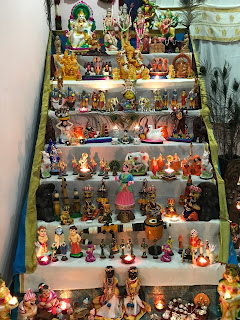Hidden Meaning of Lord Natraja --- Remembering my Guru's words...
This could be my 2nd post in this blog relating dance, but this time the pitch can be a bit different.
Dance has been my passion since a child (I attended my first dance class when I was 7 years old) and it always holds a place in my priority lists (no wonder, I learnt how to ride a bicycle simply to attend my classes).
My parents and family encouraged me when I expressed my interest in the art and soon got my admission to dance under my guru 'Sri Avasarala Rukmaji Rao'. He not only developed my interest in art but also inculcated the right thought and showed me a path to get myself involved in the ocean of dance. Under his tutelage, I was trained to learn, understand and practice more than the art. According to him, it's not simply learning the art but he made us live the art.
Almost about 12 years ago, I was learning a composition "Ananda Natamaduvar Tillai", which explains the cosmic dance (Tandava) of lord shiva as Natraja (Ananda tandavam of Nataraja) in Chidambaram. During one of these sessions, our guru asked us what the idol of Nataraja actually meant. Our answers were random. He then explained us the hidden meaning behind the divine symbol of Natraja.
NATARAJA --- Lord of Dance & The king of Dancers...
Lord Shiva as Nataraja, a cosmic dancer is believed to perform all the cosmic activities that are necessary for the existence of universe. According to the Hindu mythology, Natraja dances for the eternal bliss with wild and graceful gestures that project the cosmic illusion and explains the "Pancha Kritya" (5 works creation, maintenance, destruction, concealment and favor) performed by him. The inbuilt meaning in the idol was explained as follows:

Upper right hand of Natraja is seen with the drum (Dumrook), which explains the origin of sound and the rhythm of life, which couples with the 'Aether' (Akasha - first of the 5 elements according to Indian Philosophy).

Upper left hand of the deity is seen as the 'Ardha Chandra hasta' (halfmoon) and is seen holding the flame, which symbolizes Fire (the second element), an element symbolizing the destruction.
These two upper hands, explains the balance between creation and destruction seen in the universe.


His right, left and the third eye explains the sun, moon and the fire and the snake around his waist is believed to be the inbuilt energy (kundalini) in every living organism.

Upper right hand of Natraja is seen with the drum (Dumrook), which explains the origin of sound and the rhythm of life, which couples with the 'Aether' (Akasha - first of the 5 elements according to Indian Philosophy).

Upper left hand of the deity is seen as the 'Ardha Chandra hasta' (halfmoon) and is seen holding the flame, which symbolizes Fire (the second element), an element symbolizing the destruction.
These two upper hands, explains the balance between creation and destruction seen in the universe.

- The lower right hand means the 'Abhaya Hasta', which explains that he is the savior of all the life.
- the opposite hand is stretched (similar to that of the elephant trunk, reminding Ganesha, who removes obstacles) and points the uplifted left foot.
- Both together signifies that he offers salvation to his devotees, when they seek his help.

- One can also see a demon 'Apasmara Purusha' (named Muyalaka) under the right foot of the lord. The dwarf demon represents ignorance and forgetfulness in human. The posture of the deity explains that the ignorance will be stamped under his feet.
- The arc of flames (Prabhavati/prabhamandala), signifies the energy, perpetual motion of the earth (another element) and also the transcendental light of knowledge and wisdom.
- The crescent moon projects the benevolence and the beauty as coupled factors of existence.
- River Ganga flowing through his matted hair explains the water element and signifies the eternity of life.
And, most importantly, his peaceful face represents neutrality and thus the overall balance.
P.S: Maybe I missed writing few told by my sir, but every word he spoke still rings in my ears and they have some really great impact on the way I learned the art.





Comments
Post a Comment